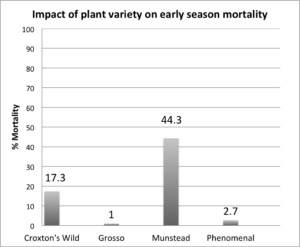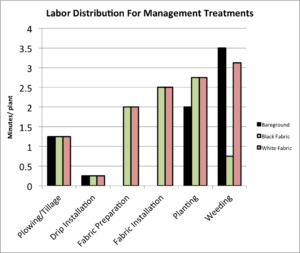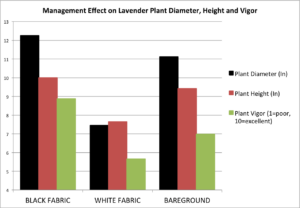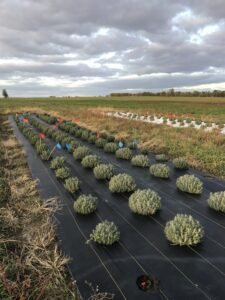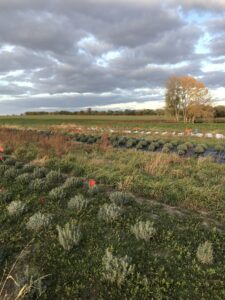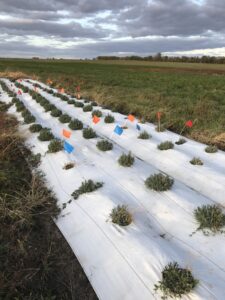Final report for FNC18-1152
Project Information
Flint Hills Lavender Farm was officially registered as an LLC in spring of 2017. The farm is
owned by Mary and Aaron Yoder and operates within a multigenerational farm owned by Mary’s
parents, Harry and Melanie Byram. The 160 acres of the family farm have been devoted primarily to
cattle and hay production for the past 30 years. The land currently devoted to lavender production is
between 1 and 2 acres, with a goal of 7 acres to eventually be dedicated to lavender production. This
will be influenced by the ability of the farm to minimize production costs and produce adequate yields.
Eventually, FHLF intends to incorporate agro-tourism and oil distillation to increase visibility of the
farm and provide new income streams. The multi-generational nature of the homestead is a
cornerstone of FHLF, as historical farm knowledge and skills are passed down and new ventures are
worked on cooperatively. While livestock operations will likely remain an important facet of the farm,
opportunities to diversify into alternative crops are at the forefront of the farms’ long-term vision.
Aaron has spent the past 12 years working in various areas of agriculture including on small,
diversified farms (5-10 acres), mid-size diversified farms (100-200 acres) and with large commercial
farms (1000+ acres) throughout the country (Kansas, Arkansas, California, Michigan, Ohio). He
received his B.S. in Horticulture in 2011 from Kansas State University and his M.S. in Horticulture
from Michigan State University in 2014. For his Master’s research, he conducted research on
optimizing production of horticultural crops using cover crops and plastic mulches. Following
completion of his M.S., he worked for two years as a technician at MSU where he helped perform
variety and product trials on commercial potato farms throughout the state of Michigan. In early
2017, he and Mary moved back to Kansas to live with family.
The Flint Hills region of Kansas is a unique ecosystem in the heartland of the United States that is dominated agriculturally by cattle ranching and hay production. Attempts to diversify agricultural crop production here can be challenging due to the variable climate, rocky terrain, and calcareous soils. One alternative crop identified as having commercial potential is Lavender (Lavandula angustifolia and L. x intermedia) due to its drought tolerance, preference for high pH soils, and the local demand for lavender products. One particularly evident challenge facing lavender production is the need to reduce labor inputs (weed management, harvesting, planting, etc.).
Additionally, variable precipitation and temperatures can reduce production potential.
To address these issues while preserving natural resources, three production systems will be evaluated for four lavender varieties. These systems include: bare ground (cultivated), white landscape fabric, and black landscape fabric treatments. To assess the effectiveness of each system, measures of crop health, yield in addition to soil temperatures and moisture will be collected throughout the duration of the project. Labor hours will also be calculated in each treatment to assess potential labor reductions.
- Establish research plot using various commercially available lavender varieties and mulching treatments.
- Collect and summarize data on plant vigor, mortality, crop yields, soil temperature, soil moisture and labor usage for each treatment combination.
- Assess the effectiveness of each treatment, and develop hypotheses for observations made.
- Share the results of the project with other current and potential lavender growers via the United States Lavender Grower’s Association (USLGA), website and social media outlets, and at regional lavender grower via the United States Lavender Grower’s Association (USLGA), website and social media outlets, and at regional lavender grower meetings.
Cooperators
- - Technical Advisor (Educator)
- - Technical Advisor (Educator and Researcher)
Research
The project treatments will include various measurements throughout the duration of the project. Data collection will be made from ‘plot plants’, located in the interior 2 rows of each bed (10 plants per treatment) to avoid artifacts from plot edges.
-Plant mortality- plants will be counted as either ‘live’ or ‘dead’ at each collection date (monthly according to timeline)
-Plant vigor- during the growing season, plant vigor will be assessed on plot plants using a visual rating system (1=weak growth, substantial plant dieback; 10=vigorous, lush, healthy growth)
-Yield- Lavender yield will be determined by quantifying the number of bundles produced from plot plants in each treatment x variety combination. Initial yield will be quantified in bundles (2” bundle diameter at stem base). Following drying of bundles, buds will be stripped, cleaned and weighed to determine total dried bud weight.
-Soil Temperature- Soil temperatures will be collected by placing the temperature probes at rooting depth at mid-day on collection days. Aggregate readings will be averaged from three points in each treatment plot.
-Soil Moisture- Soil moisture data will be collected by placing soil probes at rooting depth on sample collection days (see timeline). Following moisture readings, plots will be irrigated as needed.
The first data collected following planting was initial mortality caused by transplant shock. Fabric treatment effects produced similar numbers among varieties and the averaged varietal mortality is displayed across mgmt. treatments. Interestingly the two hybrids ('Phenomenal' and 'Grosso') fared much better than the two English lavenders ('Munstead', 'Croxtons' Wild'). In previous plantings, a loss of around 10-20% has been typical.
Labor was tracked for each task during the 2018 season and the breakdown of this is seen in the figure below. Labor is displayed on a per plant basis. Cumulative numbers for each treatment were 7, 9.5, and 11.9 minutes/plant for the bareground, black, and white fabric respectively. It is worth noting that the amount of time taken to prepare and install the fabric was substantial (4.5 min/plant) and would likely be reduced by at least half in subsequent plantings as insight was gained on more time efficient installation techniques. The white fabric did not adequately restrict light, and explains the substantial amount of time spent weeding that plot. The black fabric treatment required the least amount of weeding (.75 min/plant), compared with the white (3.125 min/plant) and bareground treatments (3.5 min/plant). This would likely be reduced in subsequent years as the lavender plants occupy more space in the holes, restricting weed growth.
Soil moisture readings were taken during the growing season as weather allowed. The probe was calibrated by placing it in completely saturated soil of the same texture as a reference (reading of 10). 3 readings were taken in each plot and averaged. The chart below shows soil moisture readings during the summer months of 2018. As can be seen from the chart, the white fabric was often the driest and required the most irrigation. The substantial growth of weeds likely caused this, as water was utilized by the competing vegetation. The bareground and black fabric treatments tended to have similar readings, although the season-long average readings were slightly higher in the black fabric (7.7) than the bareground (7.4).
At the end of the season, plant height, width and vigor data was collected and is presented below. Charts for each variety in addition to an overall average across mgmt. treatments showed similar trends, that under the black fabric, plants tended to be larger and more vigorous. This can be seen in the picture displayed below as well. It seems likely that much of this is due to weed competition. While the bareground plots were weeded as needed, it definitely experienced some competition from weeds during the growing season in between weeding events.
While 2019 was positioned to be an important year for data collection, a nearly complete crop failure occurred following the winter of 2018. Constantly saturated soils and massive temperature fluctuations were likely the cause for this. It was simply not possible to collect any yield data, which was particularly disappointing given the promising results from 2018 in the black fabric treatments. Although the dataset is not as complete as we had hoped there are a few important lessons learned from the trial that we will take as we move forward and hopefully can serve other growers in their lavender growing ventures. The black fabric, although somewhat cumbersome to install without a fabric laying machine, ended up providing a more than acceptable level of weed control in comparison with the bareground treatment. Surprisingly, it did not contribute additionally to heat-related mortality, even during the very hot days following transplanting. It was similar in its irrigation demands with the bareground treatment based on our method of soil moisture assessment, perhaps retaining a slightly higher level of soil moisture. Honing in on irrigation scheduling for lavender will be a priority for us in the future. The higher, wider and more vigorous plants that the black fabric produced were encouraging, and although this did not translate into higher yields, it seems to reason that this would likely be the case if the plants had survived the winter. Additional challenges that the fabric creates can likely be overcome and the benefits probably outweigh the costs in situations where weed management is a particular issue.
Educational & Outreach Activities
Participation summary:
Two educational activities were performed in 2018:
A presentation (with handouts displaying project results from the 1st year) was made at the fall 2018 USLGA region 6 growers meeting in Scott City, KS. There were approximately 30 people (primarily lavender growers in the Great Plains region) in attendance. Many questions and stimulating discussion occurred during the presentation.
An article was written in the USLGA newsletter, distributed to USLGA members quarterly. Originally this article was going to be published in the fall of 2018, but it ended up getting published later in the winter. Although it can't accurately be quantified as to how many people read the newsletter, the USLGA contains over 500 members who would have received the newsletter. The articles main purpose was to summarize the project (background information, treatments, etc..).
Following summary of the study, a presentation and was made at the USLGA region 6 fall meeting in Holden, MO at Mystic Meadows Lavender farm. The group had around 30 participants and approximately half of those attending had not seen the presentation from the previous years fall conference. Following the presentation was a Q&A and discussion amongst members with subject matter revolving primarily around cultural methods for growing lavender in the harsh conditions of the Great Plains. The powerpoint presentation is linked below.
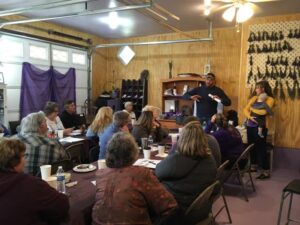
Learning Outcomes
-Landscape fabric has the potential to reduce water usage for lavender, and in a dry year (such as in 2018), it can reduce substantially the level of irrigation needed by the establishing crop.
-While we had record high temperatures in May, mortality from heat stress did not seem to adversely impact plants in the black fabric treatments. It was thought that the additional solar radiation absorbed by the fabric could kill the plants but we did not observe this, even through we experienced temperatures in the mid 90s.
-The white fabric is not a practical option, primarily due to the fact that it did not reduce weed pressure, and even required more effort to keep weeds under control. A white fabric with black underlayer would make more sense, although the lack of adverse affects on the black fabric from heat would suggest this would be unnecessary.
-We have also learned from the installation of our plots, and will be better prepared to utilize fabric with this experience under our belts. It is absolutely critical that the fabric be covered on the edges, and the high wind environment makes extra securing measures worthwhile.
-Perhaps the most critical aspect of lavender production relates to properly siting a planting. In the Great Plains environment, one if the biggest culprits (which we experienced substantially) of plant mortality is winter kill. Protection from the cold, dessicating winds from the north west are apparently essential to sustain a lavender crop from year to year. An occasional mild winter will give the false impression that lavender doesn't need as much protection as it really does here. The near total loss of plants from the test plot in year two of the study highlight this point. Not only did this hamper our ability to collect valuable data from the 2nd year, but it also was disheartening based on the amount of work that went into establishing the plot.
-Compared with maintaining a cultivated field, black fabric has the potential to offset the labor costs of weeding, although the inital costs are higher. Assuming a labor cost of $10.00/hr labor savings could be seen after 3 years as demonstrated in the below chart. It's likely that this cost recovery would occur even sooner based on the high cost of fabric installation and that this would be greatly reduced based on experience and revised techniques to install it. These scenarios don't take into account differences that might be seen in crop yields, which, based on the higher growth and vigor we saw in 2018, could very well substantially higher under fabric.
Fabric cost recovery scenarios
Project Outcomes
Perhaps the greatest success story of the project were the lively and engaging discussions that were had at the regional lavender growers conferences. There is a strong desire to learn among these growers and to try new ideas. The challenges that growers in the Great Plains face are significant, and though sometimes disheartening when crop failure occurs, it's encouraging to see so much enthusiasm within the group. The discussions also highlighted the slight differences in microclimate that we experience within our region and highlight how lavender production is impacted by soil type, drainage, slope, etc. This project also provided a good talking point regarding the value of on-farm research and how it can be most effective (replication, randomization, consistency of data collection).
